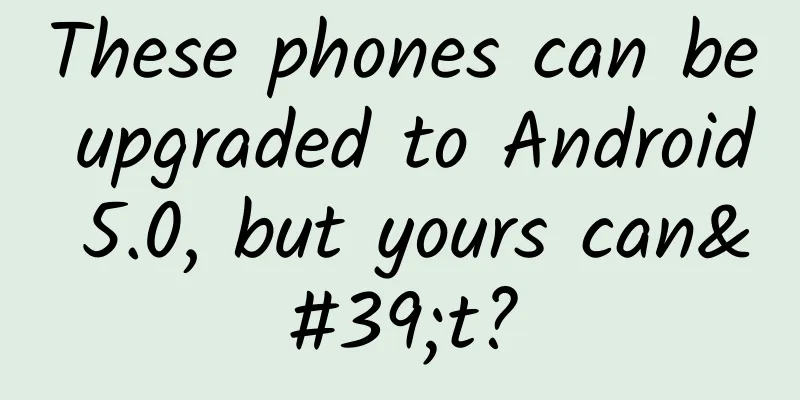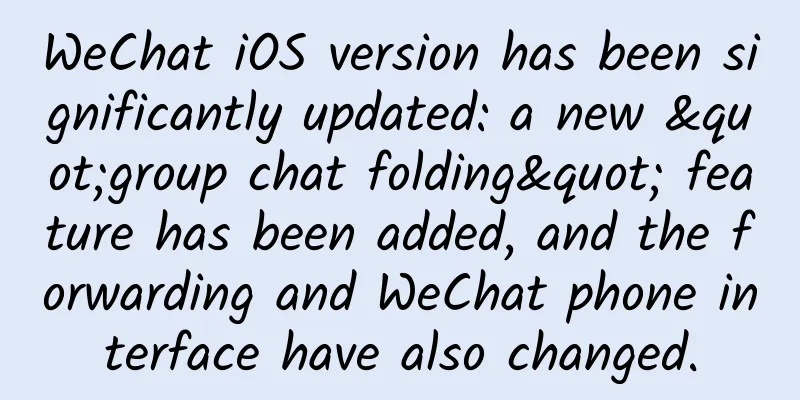These phones can be upgraded to Android 5.0, but yours can't?

|
According to the information we have received so far, many models of international mobile phone brands such as Google (Nexus), Motorola, HTC, LG and Sony have been confirmed to be compatible with the official version of Android 5.0. However, since the manufacturers have not announced the specific timetable for updating the official version of Android 5.0, we can only provide you with the models that have been confirmed to be upgraded. The specific time for each brand model to finally adapt to the official version of Android 5.0 depends on the adaptation progress of each mobile phone manufacturer. The detailed compatible models are as follows: Google (Nexus) Smartphone devices: Nexus 5, Nexus 6 (pre-installed) At present, Nexus 4 has not received any official adaptation information, but it will definitely be upgraded to Android 5.0 in the future. Don't worry, it's just a matter of time. Tablet devices: Nexus 7 (2013 WiFi Edition), Nexus 7 (2012 WiFi Edition), Nexus 10, Nexus 9 (pre-installed) TV Box: Nexus Player Motorola Moto X (2013 version), Moto X (2014 version) Moto G (2013 version), Moto G (2014 version) Moto E Droid Ultra, Droid mini Moto Defy (Princess Diana) HTC Google Play version of One M8 and One M7 (roughly upgraded between November and December this year) HTC Desire EYE, HTC M8 Dual SIM Edition, HTC M7 Dual SIM Edition, HTC One E8 (including Dual SIM Edition), HTC Butterfly 2 (roughly upgraded between January and March next year) HTC One Mini 2, HTC Desire 816 (roughly upgraded between March and April next year) HTC One Max, HTC One Mini, HTC Butterfly S (roughly upgraded between March and May next year) LG LG G3 (Korean version now receiving update push), LG G2 Samsung Samsung Note 4, Samsung Note Edge, Samsung GALAXY S5, Samsung GALAXY S4 Sony Smartphones: Xperia Z, Xperia ZL, Xperia ZR, Xperia Z1, Xperia Z1 Compact, Xperia Z1S, Xperia Z Ultra, Xperia Z2, Xperia Z3, Xperia Z3v (customized version for US operator Verizon), Xperia Z3 Compact Tablets: Xperia Tablet Z, Xperia Z2 Tablet, Xperia Z3 Tablet Compact The above is the progress of the Android 5.0 upgrade for some models that we have obtained so far, but I believe everyone wants to know why there are differences in the upgrade time of Android phones? Four factors determine the progress of system upgrades Let me explain it in one sentence: "For various devices in the Android ecosystem, when to update to the latest system is jointly determined by Google, device type, manufacturer, and operator." Every time a new Android system is released, different mobile phone manufacturers have different times to get the source code. Generally, whoever has a strong relationship with Google can get the first chance to release it. For example, after Android 5.0 is released, the one who exposes the most Android 5.0 adaptation interfaces will be close to the release date. To be more specific, the following four factors play a decisive role. Determining factor 1: System customization The degree of customization of the system by the manufacturer is the key to whether the device can be quickly upgraded to the latest Android system. For example, the Android system installed on Motorola phones has fewer changes than the customized systems of other manufacturers, so Motorola's workload in matching the new system is relatively low, so the system upgrade speed will be faster. In contrast, well-known international manufacturers such as Samsung and HTC have made significant changes to their systems, such as the familiar TouchWiz and Sense, which have been heavily customized to differentiate themselves. While increasing functions, they have also spent more energy on secondary development of the system, thus slowing down the speed of new system updates. Determining factor 2: the number of models Another factor is the number of models. For example, Android heavyweight manufacturers release many new products every year, so it is impossible to upgrade so many models to the new Android system at the first time. Therefore, most manufacturers will prioritize the adaptation and upgrade of the systems of major models. Take Samsung as an example. In 2013, Samsung released more than 40 new models. Since these phones have various configurations, they need to match the screen size, resolution, hardware configuration, camera, etc. This consumes much more energy than Apple, a manufacturer that only launches two devices a year. Determining factor 3: Necessity of upgrading old models Speaking of old devices, it’s not that manufacturers don’t value them. It’s mainly because some mobile chips may be incompatible with the new system due to the aging of the processor. In this regard, manufacturers will choose the upgrade targets based on the priority of their products. Generally speaking, this year’s flagship model has a higher upgrade priority than last year’s flagship model, and then higher than the flagship model of the year before. It can be said that every different device needs to be re-adapted to the new system, mainly at the application layer and UI layer. As for why those old devices cannot be upgraded to the new version of Android in the first place, in fact, there is also the idea of manufacturers to encourage users to buy new products. After all, Android 5.0 is the core of Android phones and is also a significant selling point. Of course, for those old devices that have been launched for several years, manufacturers will not spend too much effort to upgrade and match them, because even if the match is successful, it will not help if the operating experience is terrible. Determining factor 4: Operator priority judgment Another factor is the carrier, take a Moto X upgrade progress chart from last year as an example. In the chart, you can see that different carriers have different timelines for Moto X to upgrade to Android KitKat. In comparison, the unlocked version of Moto X obviously gets the fastest upgrade, while the Verizon version of Moto X takes the longest time. Moreover, on the carrier side, the upgrade speed of non-mainstream devices is even slower. These phones can be upgraded to Android 5.0, but yours can't? This is true for foreign operators and domestic operators as well. I believe you often hear friends around you wondering, my Unicom version of the phone has received the OTA push upgrade, but my colleague's Telecom version has not received it yet? Let me explain the reason. Operators' demands on mobile phone manufacturers are mainly concentrated on two things. The first is application adaptation, including localized applications and operator applications; the second is network adaptation. For example, telecom customized phones require manufacturers' equipment to shield TD-LTE and FDD-LTE networks. However, due to the differences in localized services provided by operators in different countries, there are differences in the speed of progress. For example, the first operator-customized LG G3 phone came from Poland, so you can understand this as a competition among operators. Why are domestic manufacturers upgrading more slowly? Of course, domestic users will be more concerned about the progress of domestic smartphone brands adapting to the official version of Android 5.0. From the information we have learned before, Xiaomi, Meizu, Lenovo and other brands are also stepping up their efforts to adapt to the official version of Android 5.0, but no domestic mobile phone manufacturer has announced that its related models will be adapted to the official version of Android 5.0. The reason is that after obtaining the official version of Android 5.0, domestic smartphone manufacturers still need to carry out a lot of "localization" processing. Take the familiar MIUI as an example. A phone book function needs to add some functions such as "caller location", "blacklist", "yellow pages query" and so on to facilitate domestic users. This undoubtedly increases the adaptation workload of the domestic mobile phone ROM team. After upgrading to Android 5.0, the application compilation mode of the Android system is updated from the previous Dalvik mode to the ART mode. Because of the different compilation modes, the applications will need to be re-adapted. Although the deeply customized systems of domestic mobile phone manufacturers have improved the localized user experience, they have sacrificed the matching time of the new system, so the system update speed will be slower. Why didn't my Android phone receive an update? Back to the topic we are discussing in this article, for most users, what they care about is when their devices can receive the push upgrade of the Android 5.0 system. In summary, the adaptation and upgrade of Android is far from as simple as imagined. Google, device type, manufacturer, and operator are all factors that determine whether the Android device in the hands of users can be upgraded to the new Android system. For domestic mobile phone manufacturers, the progress will be slower, and the customization of a large number of localized applications will take more time. From this point of view, it seems that being anxious is not a solution, so just wait patiently! As a winner of Toutiao's Qingyun Plan and Baijiahao's Bai+ Plan, the 2019 Baidu Digital Author of the Year, the Baijiahao's Most Popular Author in the Technology Field, the 2019 Sogou Technology and Culture Author, and the 2021 Baijiahao Quarterly Influential Creator, he has won many awards, including the 2013 Sohu Best Industry Media Person, the 2015 China New Media Entrepreneurship Competition Beijing Third Place, the 2015 Guangmang Experience Award, the 2015 China New Media Entrepreneurship Competition Finals Third Place, and the 2018 Baidu Dynamic Annual Powerful Celebrity. |
<<: Panasonic's new air purifier F-655FCV is available first
>>: YotaPhone: Learning from Xiaomi in China
Recommend
14 photos summarize Steve Jobs' life
Today is the third anniversary of the death of th...
Solid info! 6 customer acquisition models for APP promotion!
This time, I spent 2 days researching various pop...
7 SEM promotion creative title routines, have you used them all?
Internet promotion, especially mobile Internet pr...
TIKTOK won’t install? It costs 10 yuan to install it once. This information gap is too profitable.
TIKTOK won’t install? It costs 10 yuan to install...
Will artificial intelligence bring about an education revolution? Hujiang joins hands with Tencent and Sony to develop an intelligent learning platform
On April 27, the technology event GMIC2017 opened...
28 thoughts on marketing, operations, copywriting, and new media!
1 What is a brand? It seems that there are very f...
How to debug Android Framework?
Linus has a famous saying that is widely known: R...
How much does it cost to develop a mini program? How much does it cost to make a mini program?
With the rapid development of the Internet, mini ...
Internet finance, how to quickly acquire a large number of real target users?
“Just like true love, you never need to chase aft...
Can you make sales on Douyin explode? Use this formula!
I saw a TikTok video a few days ago. It showed st...
What are the unspoken rules of Baidu’s bidding agents?
Agents 1. Before the peak season, agents will inc...
Opening the era of family cars 3.0, China's most powerful super multi-purpose family car - Trumpchi E8 is officially delivered
On December 9, on the Bund in Shanghai, accompani...
TalkingData's third anniversary brand strategy conference was held in Beijing
Mobility changes tradition, data changes the futu...
PaPa Pocket Cinema Review: A compact and portable 100-inch TV
In the first quarter of 2015, the smart micro-pro...
You can get as many likes as you want on WeChat! This like tool is amazing
Since WeChat added the Moments feature, the most ...









